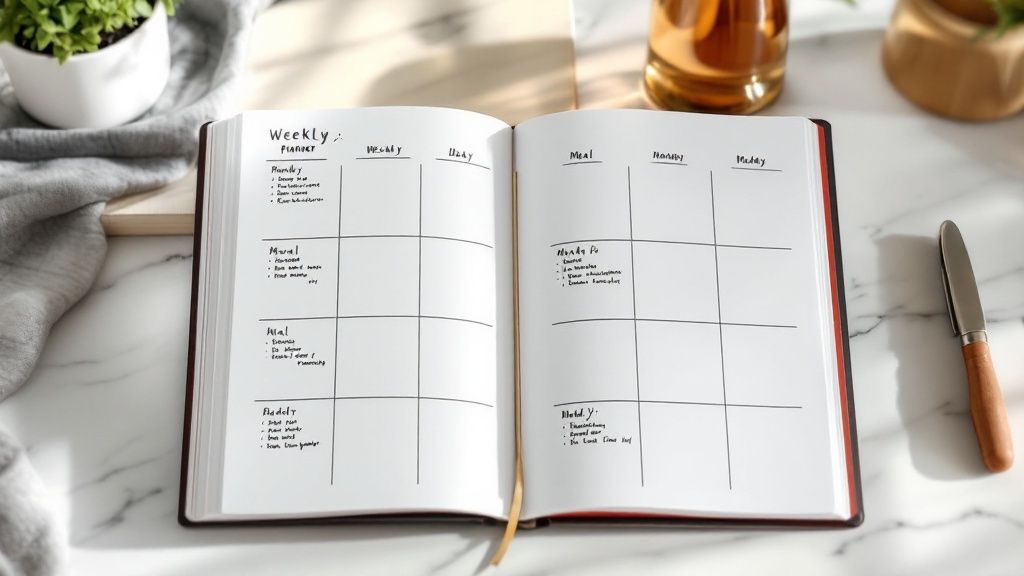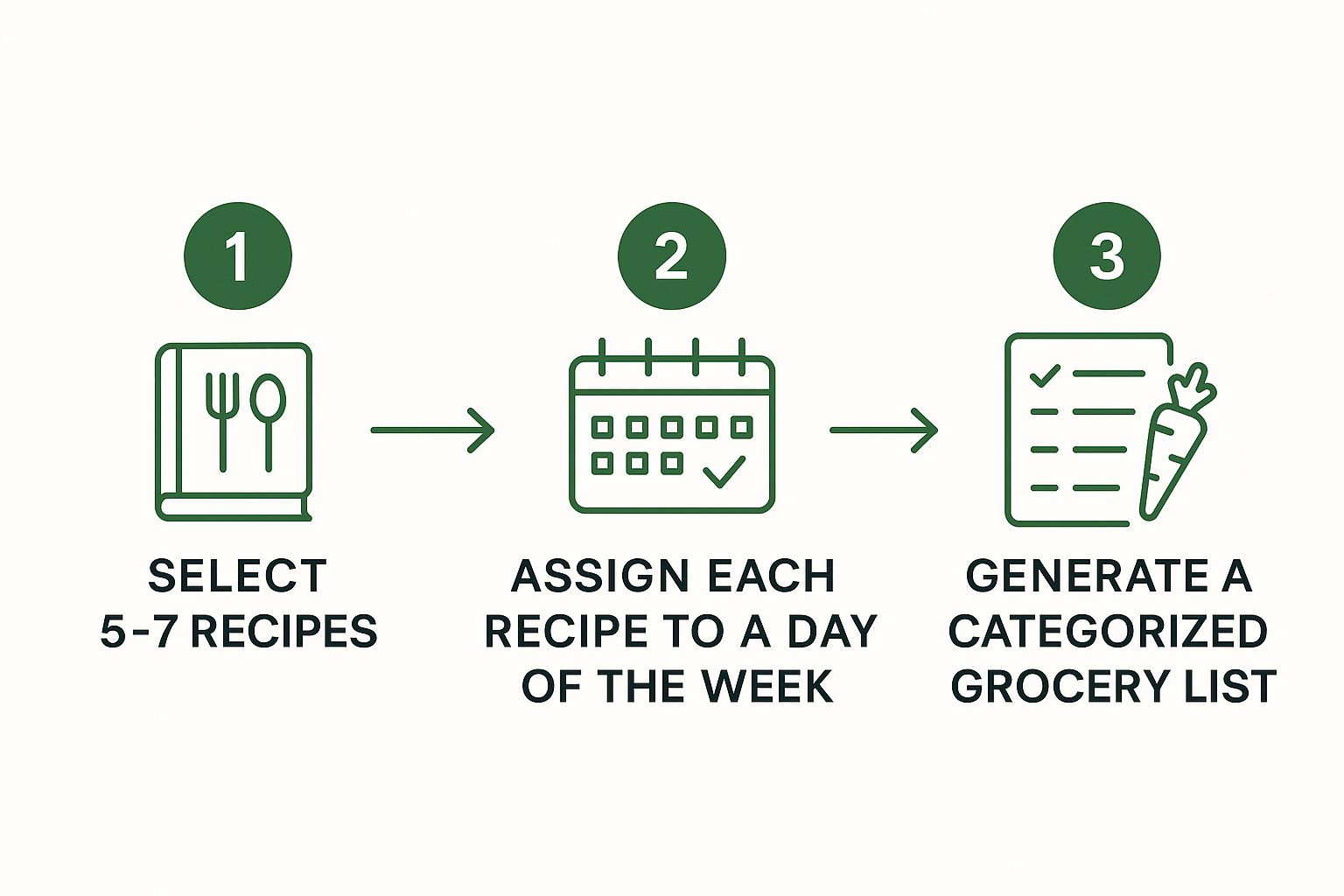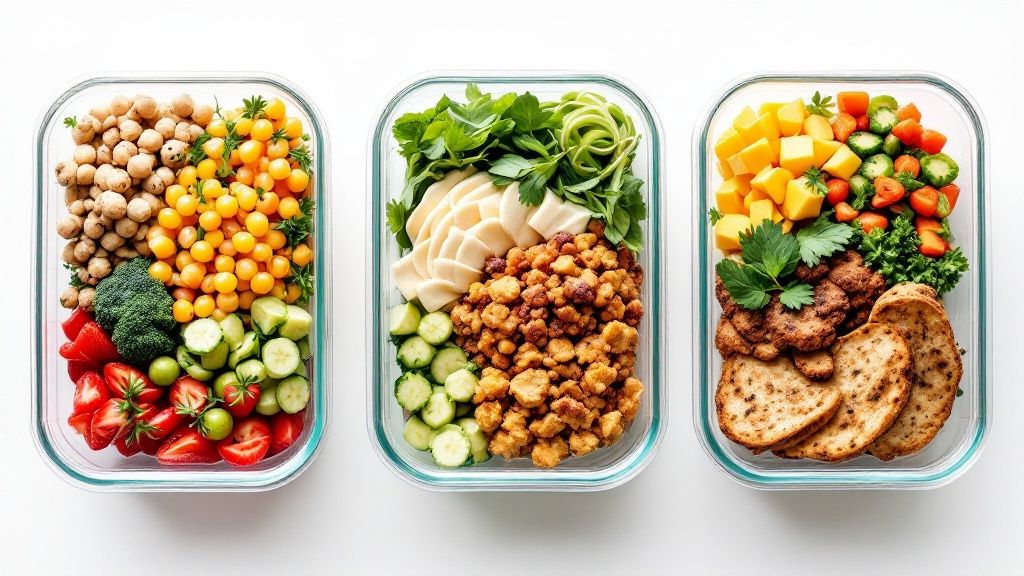How to Plan Weekly Meals Without the Stress
Before you even think about recipes or cookbooks, let’s get one thing straight: the best meal plan is the one built for your actual life, not some idealized version of it. It’s about understanding your rhythm first, then picking the food. This simple shift in perspective turns meal planning from a dreaded chore into a genuine stress-reducer.
Building Your Meal Planning Foundation

So, before diving headfirst into Pinterest for dinner ideas, take a step back and look at what you’re already working with. A little prep work here makes the whole process ridiculously easier down the line.
First, do a quick “kitchen audit.” Seriously, just open your pantry, fridge, and freezer. What’s in there? That forgotten half-bag of quinoa, the frozen chicken breasts you bought on sale, those canned tomatoes pushed to the back—these are your secret weapons. Building meals around what you already own is one of the smartest food waste reduction strategies out there, and it saves you money instantly.
Define Your Primary Goal
Next, get crystal clear on your “why.” What’s the number one reason you’re doing this? Your answer will be the compass for every food choice you make.
- Saving Money? You’ll be hunting for recipes that use cheap pantry staples, make proteins go the extra mile, and lean heavily on what’s on sale at the grocery store.
- Eating Healthier? Your focus will shift to whole foods, lean proteins, and maybe even getting specific with portion sizes.
- Reducing Stress? The name of the game is simplicity. We’re talking quick, easy recipes for those chaotic weeknights to slash that “what’s for dinner?” panic.
Trying to do it all—making gourmet, ultra-healthy, budget-friendly meals in 15 minutes every night—is a surefire way to burn out. Pick one main goal to start. You can always layer in others later.
Get Real About Your Schedule
Finally, it’s time for a dose of reality. Pull out your calendar and be brutally honest with yourself about the week ahead. Pinpoint the evenings you’re working late, the nights the kids have practice, and the days you just know you’ll be too exhausted to cook anything complicated.
This is where you match the meal to the moment. Some nights call for a 20-minute “assembly” job (think tacos or big salads), while others might have space for something a bit more involved. To really lock it in, using a simple weekly meal planner that actually works can be a game-changer. It’s like creating a schedule for your dinners, making sure your ambitions line up with your actual available time. This step alone is what makes a meal plan stick.
Curating a Recipe Collection You Actually Love

We’ve all been there—endlessly scrolling through recipe blogs, feeling more overwhelmed than inspired. The secret to breaking this cycle isn’t finding new recipes every week. It’s building a personal “recipe box” filled with meals you already know are winners.
Start by gathering your tried-and-true favorites. I’m talking about the meals your family genuinely gets excited about. Pull them from everywhere: that dog-eared cookbook page, a screenshot from a blog you love, or even your grandma’s handwritten index card. These are your foundational recipes.
This is where a little modern tech can be a lifesaver. Digital meal planning apps have become a go-to for so many people, especially those in the 25–45 age group. In fact, a recent survey found that over 67% of adults in this demographic use digital meal planners or grocery list apps at least twice a week. If you’re curious, you can check out some of the top meal planning apps of 2025 to see what’s out there.
Categorize for Quick Wins
Here’s the real game-changer: it’s not just about collecting recipes, it’s about organizing them in a way that actually helps you. Forget alphabetical order. You need categories that solve a specific, real-world problem.
Think of it as turning a messy pile of papers into a powerful planning tool. Here are a few category ideas I personally use to get you started:
- 30-Minute Dinners: For those chaotic weeknights when time is nonexistent.
- Kid-Approved Favorites: The no-fail meals you know won’t get picked apart.
- Pantry Staple Meals: Lifesavers for that “I haven’t been to the store” feeling.
- Seasonal Delights: To make the most of fresh produce, which is so crucial for the role of seasonal ingredients in elevating your dishes.
Creating these categories is the difference between aimless scrolling and confident decision-making. When you know you need something fast, you just head straight to your “30-Minute Dinners” list instead of falling down an internet rabbit hole.
This organized, personal library is the true foundation of an effective, stress-free weekly meal plan. It ensures you’re always just a few clicks away from a meal you know you can pull off and your family will actually love.
Designing Your Weekly Menu and Smart Shopping List
Alright, you’ve got your recipes corralled. Now for the fun part: building the actual menu. This is where we turn that pile of “maybes” into a solid plan of “what’s for dinner this week.”
Start With Theme Nights
A fantastic way to beat decision fatigue is to lean on theme nights. Seriously, this trick is a lifesaver. Assigning a theme to each day—like Meatless Monday, Taco Tuesday, or Pasta Thursday—instantly narrows down your options. Instead of staring blankly at your entire recipe collection, you just have to pick one pasta dish for Thursday. Easy.
This approach works wonders for families, too. If you’re juggling picky eaters and chaotic schedules, having a predictable theme gives everyone something to look forward to. We dive deeper into this in our guide to meal planning for busy families.
This little visual sums up the whole workflow perfectly—from picking recipes to creating a shopping list that actually makes sense.

See how each step just flows into the next? It turns a potentially overwhelming chore into a simple, three-part process.
Turn Your Menu into a Master Shopping List
Once your meals are plugged into the week, the last critical step is building a smart shopping list. And by smart, I don’t mean just scribbling down ingredients as they come to mind. That’s a recipe for disaster (and a second trip to the store).
The most efficient method is to organize your list by grocery store aisle. Group all your produce together, all the dairy in one spot, and all the pantry staples in another.
This one tweak completely changes your shopping trip. You’ll move through the store like a pro, avoiding the dreaded backtracking and cutting down on those impulse buys that sneak into your cart. No more getting home only to realize you forgot the sour cream for Taco Tuesday.
A well-organized shopping list isn’t just a convenience—it’s your best tool for saving time and money. You get in, get what you need, and get out.
And this isn’t just anecdotal. The data backs it up. Research shows that dinner is the meal we plan most often, and about 70% of people who make a weekly plan actually stick to it. Even when life throws a curveball, they’re more likely to swap meals to different days than abandon the plan altogether, which is a huge win for preventing food waste.
Let’s walk through a quick example to see how this all comes together.
Here is a simple table showing how a 3-day themed meal plan translates into a neatly categorized shopping list, making your trip to the store quick and efficient.
| Day/Theme | Meal | Produce | Protein | Pantry/Dairy |
|---|---|---|---|---|
| Monday (Meatless) | Black Bean Burgers with Sweet Potato Fries | Onions, lettuce, tomato, sweet potatoes | Black beans | Burger buns, burger seasoning |
| Tuesday (Taco) | Ground Turkey Tacos with Corn Salsa | Corn, cilantro, jalapeño, lime, avocado | Ground turkey | Taco shells, salsa, sour cream, shredded cheese |
| Wednesday (Pasta) | Spaghetti with Meat Sauce & Salad | Garlic, bell pepper, romaine, cucumbers | Ground beef | Spaghetti, jarred marinara, parmesan, salad dressing |
See how organized that is? This structure makes your shopping trip incredibly focused. You’re not just wandering the aisles hoping for the best; you’re executing a well-designed plan.
Mastering Prep Work to Reclaim Your Weeknights

A killer weekly menu is only half the battle. The real magic, the thing that actually saves your sanity on a Tuesday night, happens during your prep session.
This is where you transform chaotic weeknights into simple, stress-free assembly jobs. Think of it as an investment that pays you back in free time all week long.
This doesn’t mean you have to lose your entire Sunday to the kitchen. Good meal prep meets you where you are, adapting to your schedule and energy. It’s a spectrum, ranging from a few simple tasks to full-on batch cooking.
Choose Your Prep Style
Finding a rhythm that you can actually stick with means understanding the different ways to approach prep. Not every week calls for the same game plan.
- Ingredient Prep: This is the most common starting point and often the most impactful. It’s all about getting the tedious stuff out of the way—washing and chopping all your vegetables, marinating proteins, or mixing up sauces and dressings. When dinner time rolls around, you just grab and cook.
- Component Prep: This takes things a step further. You’re not just prepping ingredients; you’re cooking them. Think: a big batch of quinoa, a whole tray of roasted veggies, or a few grilled chicken breasts you can slice up for salads, wraps, or grain bowls.
- Full Meal Prep: This is the classic “lunchbox” approach. You cook and portion entire meals into individual containers. It’s an absolute lifesaver for grab-and-go lunches or for those evenings when you know you’ll have zero time or energy to even think about cooking.
For a great way to infuse flavor early on and cut down on cooking time, check out this guide on how to meal prep with BBQ rubs. It turns basic prep into a quick, stress-free flavor boost.
The goal isn’t to create a rigid, unchanging system. It’s to build a flexible toolkit of prep strategies you can pull from depending on the week’s demands. Some weeks call for fully prepped meals, while others just need pre-chopped onions.
By setting aside just one or two hours for prep, you set the stage for a week of smooth sailing. This single step is what stops the weeknight time crunch from derailing all your good intentions. You’re not just preparing food; you’re buying yourself peace of mind.
Keeping Your Meal Plan Flexible and Realistic
Let’s be honest: a rigid meal plan is a fragile one. Life has a funny way of being unpredictable. A last-minute dinner invite, a sudden craving for something completely off-menu, or just a chaotic evening can throw a wrench in even the most organized schedule.
The real key to making meal planning stick isn’t about achieving perfection. It’s about building in the flexibility to adapt. That’s what turns this from a chore into a habit that genuinely reduces your stress. Think of your plan less like a set of strict rules and more like a helpful roadmap that can handle a few detours.
Build Your Backup System
One of the smartest things I ever did was create a safety net of ridiculously easy meals. You don’t have to cook from scratch every single night, especially when your past self can do you a favor.
- The Cook Once, Freeze Twice Rule: When you’re making something that freezes well—think lasagna, a big pot of chili, or a hearty soup—just double the recipe. You eat one batch that night and stash the other in the freezer. Future you will be so grateful on that evening when you have zero time or energy to cook.
- Know Your Pantry Heroes: I always have three to five “pantry dinners” up my sleeve that I can make entirely from non-perishable staples. We’re talking pasta with garlic and oil, black bean quesadillas from canned beans and tortillas, or even a simple-but-satisfying omelet. These are my go-to lifesavers for nights when the fridge is looking bare.
Your freezer and pantry aren’t just for storage; they are your emergency meal kit. A small stash of ready-to-go options is the ultimate defense against the temptation of expensive, last-minute takeout.
Learn to Pivot and Adjust
Flexibility also means giving yourself permission to change the plan on the fly. If you had chicken scheduled for Tuesday but you’re really feeling the spaghetti you planned for Thursday, just swap them. It rarely matters what order you eat things in, as long as you use the ingredients you bought.
At the end of each week, take two minutes to think about what worked and what didn’t. Did you consistently run out of time on Wednesdays? That’s valuable information. Next week, plan one of your quick pantry meals for that day. This constant, gentle adjustment is how you refine your process and turn your weekly meal plan into something that truly works for you.
Answering Your Top Meal Planning Questions
Even the best-laid plans can hit a snag. As you get the hang of meal planning, a few questions are bound to come up. Think of this as your personal troubleshooting guide for the most common hurdles.
The goal isn’t about being perfect right out of the gate; it’s about building a consistent routine that actually works for you. A few smart tweaks can make all the difference.
How Do I Handle Leftovers Without Getting Bored?
Here’s the secret: stop thinking of leftovers as a simple reheat-and-repeat meal. Instead, see them as pre-prepped ingredients for an entirely new dish. This little mental shift is a game-changer.
For instance, that roasted chicken from Sunday dinner can be shredded for tacos on Tuesday or become the star of a chicken salad sandwich for Monday’s lunch. Extra rice? Perfect for a quick skillet fried rice. By planning one or two “remix” nights, you creatively use what you have, which dramatically cuts down on food waste while keeping your menu from feeling stale.
Think of it this way: you’re not eating the same meal twice. You’re using a time-saving component to create something new and exciting. It’s the ultimate kitchen hack for efficiency and variety.
What If My Schedule Is Too Unpredictable?
When your week is all over the place, a rigid seven-day plan can feel like a straitjacket. If that sounds familiar, don’t ditch the idea entirely—just adjust your approach. A plan that doesn’t fit your life is destined to fail.
Instead of mapping out all seven days, try this:
- Plan just three or four key dinners for the week. These are your anchors—the meals you know you’ll have the time and energy to cook.
- Keep a running list of 5-7 ultra-fast ‘pantry meals’ for the other nights. These are your emergency go-tos made with things you always have on hand, like pasta with a simple jarred sauce, omelets, or black bean quesadillas.
This hybrid method gives you structure where you need it and total flexibility where you don’t. You get the benefits of planning without the pressure of a strict daily schedule, which is perfect for navigating a chaotic week.
How Can I Meal Plan on a Very Tight Budget?
Meal planning is hands-down one of the most powerful tools for managing a tight grocery budget. It forces you to be intentional with every single dollar. The key is to build your plan around cost-saving strategies from the very beginning.
Start by grabbing your grocery store’s weekly flyer and building your menu around what’s on sale. If chicken thighs and broccoli are the headliners, that’s your starting point. Next, work in more plant-based proteins like beans, lentils, and chickpeas—they’re significantly cheaper and healthier than meat. Finally, embrace batch cooking. A big pot of chili or a hearty soup often costs far less per serving and can cover you for multiple meals.
At Culinary Collective Atl, we specialize in taking the stress out of mealtime by creating personalized plans that fit your life. If you’re ready for delicious, chef-crafted meals without the planning, shopping, or cooking, learn more about our private chef services.





